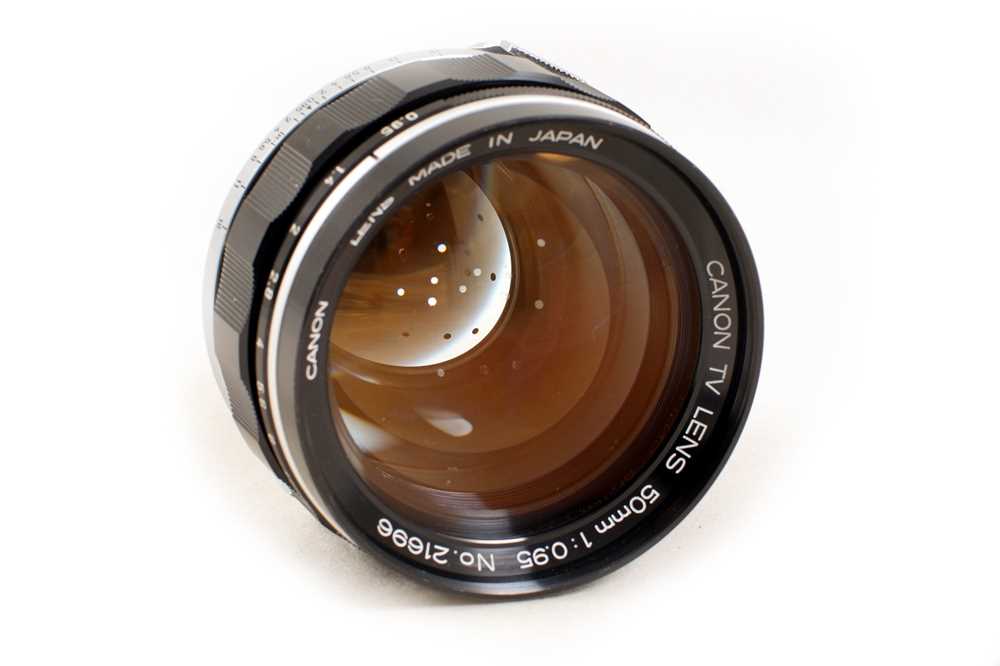What Dreams are Made of: Canon 50mm f0.95 Dream Lens

Lot 181, Canon 50mm f0.95 C-mount TV 'Dream' Lens.
At the moment I have two “Dreams"; one is on a Canon 7 in my own camera collection and the other has come in with some unusual lenses for the Photographica auction on 6 October. Both are examples of the legendary super fast Canon 50mm f0.95 lens, often referred to as their "Dream lens".
When introduced in the early 1960s, this was the fastest standard lens with a 39mm screw mount available. Like several other very fast lenses, the rear element had to be slightly ground away to make room for the rangefinder coupling. This lens only fits the unique external bayonet mount on Canon 7 series cameras.
Then, in the early 1970s, a version of the Dream lens for use on television and cine cameras was introduced, easily identified by the engraving on the inside rim. My TV example has W1000 stamped on the mount locking flange which means I can date its manufacture to October 1982.
With the exception of the rear element, both lenses look the same but the still camera version weighs 600gms whilst the TV version “only” weighs 545gms, even with a C-Mount adapter. And although at first glance the mounts look identical, the TV version will not fit directly to a Canon 7 camera so, at a later date, many TV lenses were converted for use on Leica M series cameras. Luckily this TV lens came with a rare C-Mount adapter so I thought I would try it on my Micro 4/3rds DSLR, for which I already had the correct connections.
Sadly, no luck as the mount adapter on the camera didn’t allow the lens to fully screw in, only holding on by a few threads. With such a heavy (and expensive lens) it didn’t feel at all safe. Luckily, I managed to find a x2 C-Mount tele converter which then provided enough clearance to allow the lens to screw all the way home. If I am working things out correctly, I think I now have (roughly) a 200mm f1.4 lens (a 50mm lens on a M4/3rds = 100mm, plus a x2 converter = 200mm, less one f-stop for the converter).
Dreams Lens in Action
So how was this combination in use? I think “hard work” just about covers it. Even though the viewfinder of my DSLR remains bright even when a lens is stopped right down, there is no focus confirmation indication. Add that to the almost non-existent depth of field with this set-up and the ungainly way I had to hold and focus the lens, I really struggled.
The other, more obvious problem is that using a f0.95 lens wide open means you often run out of shutter speeds, even on overcast days and with a low ISO setting. The top speed on my Olympus OM-D is 1/4000th second and even then I was occasionally overexposing. Stopping the lens down to f11 or so cured the problem, but then that makes using this lens almost pointless. It really wants to be used wide open.
Next was the quality of the results. Wide open the images were soft (possibly compounded by my focusing difficulties) and suffered from colour fringing. In the images of an unloved planter in a very dark corner of my garden, I noticed the colour of the image in the viewfinder changed considerably as I stopped down. Once I was down to f8 or f11 things improved dramatically, producing some pleasing results.
These lenses have achieved cult status today and high prices around £2,000 abound. Even the prices of original lens caps, hoods and filters will make your eyes water.
Although they wouldn’t be an exact comparison, I had hoped to run these two lenses side-by-side and compare the results. I shot a roll of film with my own lens on the Canon 7 over a weekend and popped into my local Kodak Express franchise first thing on Monday to have it processed. I was told they would send if off on Wednesday and it would be back the following Wednesday. I make that a 10-day turnround, a far cry from the one-hour service we all got used to having not all that many years ago. I nearly told them they might want to reconsider the name of the shop, but thought better of it.
My savior however was Dave at AG Photolabs in Birmingham. I sent the film to him (Freepost) Monday afternoon and by lunchtime Tuesday he emailed me back a set of digital files with prints in the post.
Sadly, the only colour film I had to hand was over 35 years out of date and unsurprisingly the images suffered considerably. Onto the backburner for a second try I guess.
Photographica, Wednesday 6 October, 12pm. View the catalogue here.
Written by Tim Goldsmith and originally published in Cameracraft magazine.